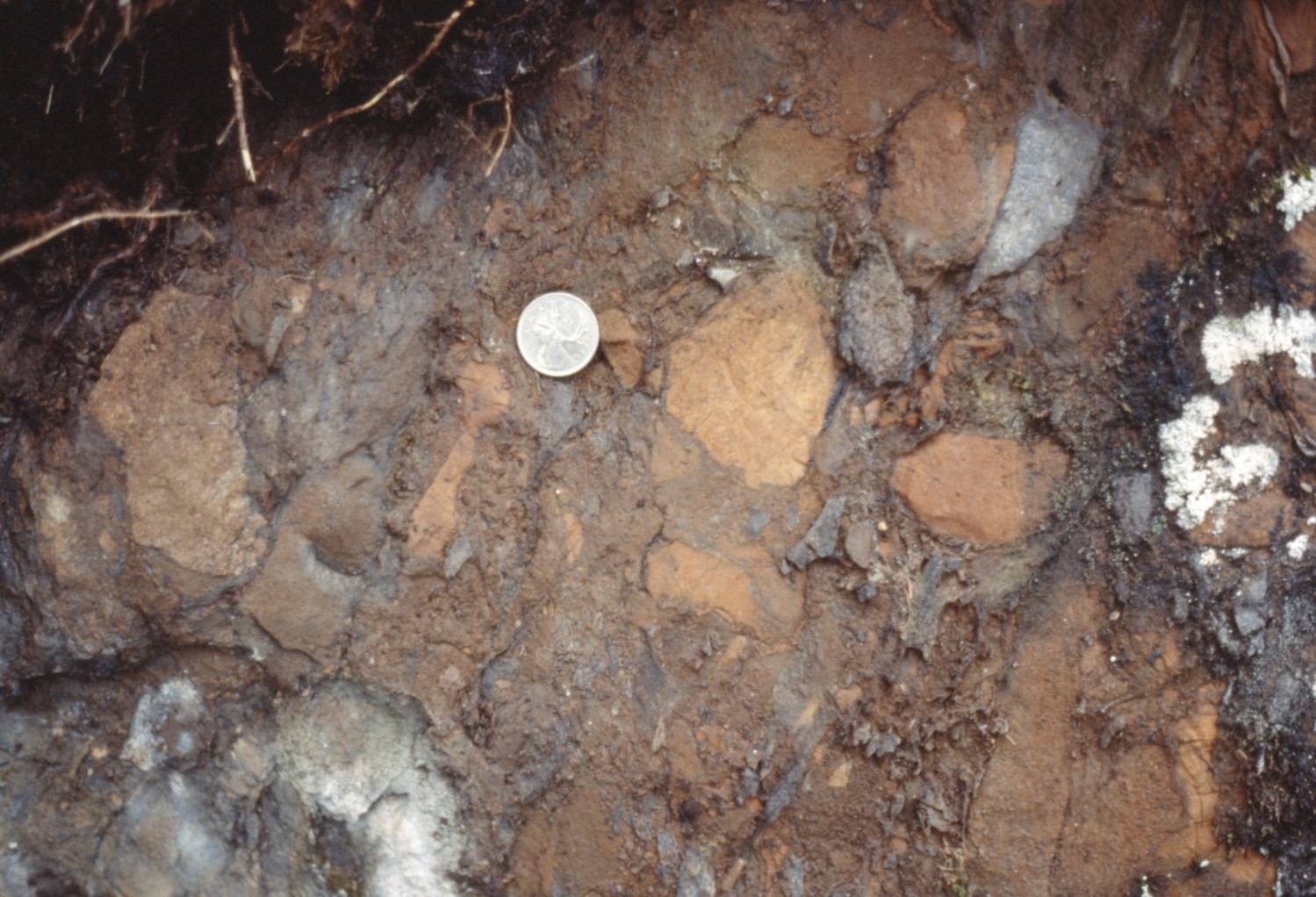
DISCLAIMER: This English version is translated from the original French. In case of any discrepancy, the French version shall prevail.
| Author(s): | Clark and Wares, 2004 |
| Age: | Paleoproterozoic |
| Stratotype: | None |
| Type area: | Douay, Aulneau and Erich-Dimroth lakes area, west of Le Moyne Lake (NTS sheets 24C16, 24F01 and 24F02) |
| Geological province: | Churchill Province |
| Geological subdivision: | New Quebec Orogen (Labrador Trough)/Gerido Lithotectonic Zone |
| Lithology: | Rhyodacite, dolomite, shale, basalt, conglomerate, dolomitic tuff |
| Category: | Lithostratigraphic |
| Rank: | Group |
| Status: | Formal |
| Use: | Active |
Background
The name « Le Moyne Group » was introduced by Clark and Wares (2004) to designate a particular volcano-sedimentary sequence comprising the Douay and Aulneau formations.
Description
The Le Moyne Group is an allochthonous volcano-sedimentary unit belonging to the second cycle of the Labrador Trough. It consists of felsic and mafic volcanics, and sedimentary rocks of the Douay Formation at the base, overlain by marine platform sedimentary rocks of the Aulneau Formation (Dressler, 1979; Clark and Wares, 2004). Mafic and ultramafic tuffs contemporaneous with a carbonatite intrusion several kilometres in size (Le Moyne Carbonatite Complex) are also found in the sequence (Birkett and Clark, 1991). The Le Moyne Group represents an isolated platform that is thought to have developed in a deep basin regional setting (Clark and Wares, 2004). Rocks of the Le Moyne Group are metamorphosed to the greenschist facies (Dimroth and Dressler, 1978).
Thickness and distribution
The Le Moyne Group belongs to the Gerido Lithotectonic Zone, as defined by Clark and Wares (2004). It extends approximately 40 km in length in a NW-SE direction, over an E-W width of approximately 8 km, west of Le Moyne Lake (sheets 24C16, 24F01 and 24F02). The unit is repeated at the surface by thrust faults.
Dating
Rocks of the Le Moyne Group were deposited towards the end of the second volcano-sedimentary cycle of the Labrador Trough (Clark and Wares, 2004). A U-Pb analysis of a sample of rhyodacite from the Douay Formation gave an age of 1870 ±4 Ma, the youngest age for second-cycle rocks (Machado et al., 1997). This age allows the volcano-sedimentary sequence of the Le Moyne Group, and the associated carbonatite of the Le Moyne Carbonatite Complex, to be correlated with the Hellancourt Formation (Koksoak Group) dated 1874 ±3 Ma (Machado et al., 1997; Clark and Wares, 2004).
Stratigraphic Relationship(s)
The Douay Formation, the basal unit of the Le Moyne Group, is interbedded with mafic pyroclastic rocks of the Murdoch Formation (Doublet Group) near the carbonatite of the Le Moyne Carbonatite Complex (Dressler, 1979). in proximity to latitude 57° N, rocks of the Baby Formation (Koksoak Group) are interstratified with pyroclastic rocks of the Murdoch Formation. The whole is locally overlain by the Le Moyne Group and the Le Moyne Carbonatite Complex (Birkett and Clark, 1991; Machado et al., 1997). The Le Moyne Group correlates with the Koksoak and Doublet volcano-sedimentary groups in the northern and southern parts of the Trough and with the Ferriman Group to the west (Findlay et al., 1995; Clark and Wares, 2004). The Le Moyne Carbonatite Complex, consisting of a subvolcanic carbonatite intrusion and tuffaceous beds, was emplaced in the volcano-sedimentary sequence of the Le Moyne Group (Birkett and Clark, 1991). Finally, numerous gabbroic sills belonging to the Gerido Intrusive Suite cut the volcano-sedimentary sequence of the Le Moyne Group. According to Dressler (1979), large fragments of gneiss observed in conglomerates of the Aulneau Formation originate from an Archean source located east of the Trough. The presence of inherited zircons in rhyodacite of the Douay Formation is consistent with this interpretation (Machado et al., 1997).
Paleontology
Does not apply.
References
Publications Available Through SIGÉOM Examine
CLARK, T., WARES, R., 2004. SYNTHESE LITHOTECTONIQUE ET METALLOGENIQUE DE L’OROGENE DU NOUVEAU-QUEBEC (FOSSE DU LABRADOR). MRNFP; MM 2004-01, 182 pages, 1 plan.
DRESSLER, B., CIESIELSKI, A., 1979. Région de la fosse du Labrador. MRN; RG 195, 136 pages, 14 plans.
Other Publications
BIRKETT, T.C., CLARK, T., 1991. Géologie et potentiel métallifère de la carbonatite protérozoïque du lac LeMoyne dans le nord du Québec. Geological Survey of Canada; Work in Progress Forum, Programme and Abstracts, page 20.
DIMROTH, E., DRESSLER, B., 1978. Metamorphism of the Labrador Trough. In Metamorphism in the Canadian Shield. Geological Survey of Canada; Study 78-10, pages 215-236. doi.org/10.4095/104534
FINDLAY, J.M., PARRISH, R.R., BIRKETT, T., WATANABE D.H., 1995. U-Pb ages from the Nimish Formation and Montagnais glomeroporphyritic gabbro of the central New Québec Orogen, Canada. Canadian Journal of Earth Sciences; volume 32, pages 1208-1220. doi.org/10.1139/e95-099
MACHADO, N., CLARK, T., DAVID, J., GOULET, N., 1997. U-Pb ages for magmatism and deformation in the New Quebec Orogen. Canadian Journal of Earth Sciences; Volume 34, pages 716-723. doi.org/10.1139/e17-058
Suggested Citation
Ministère de l’Énergie et des Ressources naturelles (MERN). Le Moyne Group. Quebec Stratigraphic Lexicon. https://gq.mines.gouv.qc.ca/lexique-stratigraphique/province-de-churchill/groupe-de-le-moyne_en [accessed on Day Month Year].
Contributors
|
First publication |
Charles St-Hilaire, GIT, M.Sc. charles.st-hilaire@mern.gouv.qc.ca (redaction) Mehdi A. Guemache, P. Geo., Ph.D. (redaction and coordination); Thomas Clark, P. Geo., Ph.D. (critical review); Simon Auclair, P. Geo., M.Sc. (editing); Céline Dupuis, P. Geo., Ph.D. (English version); Nathalie Bouchard (HTML editing). |

